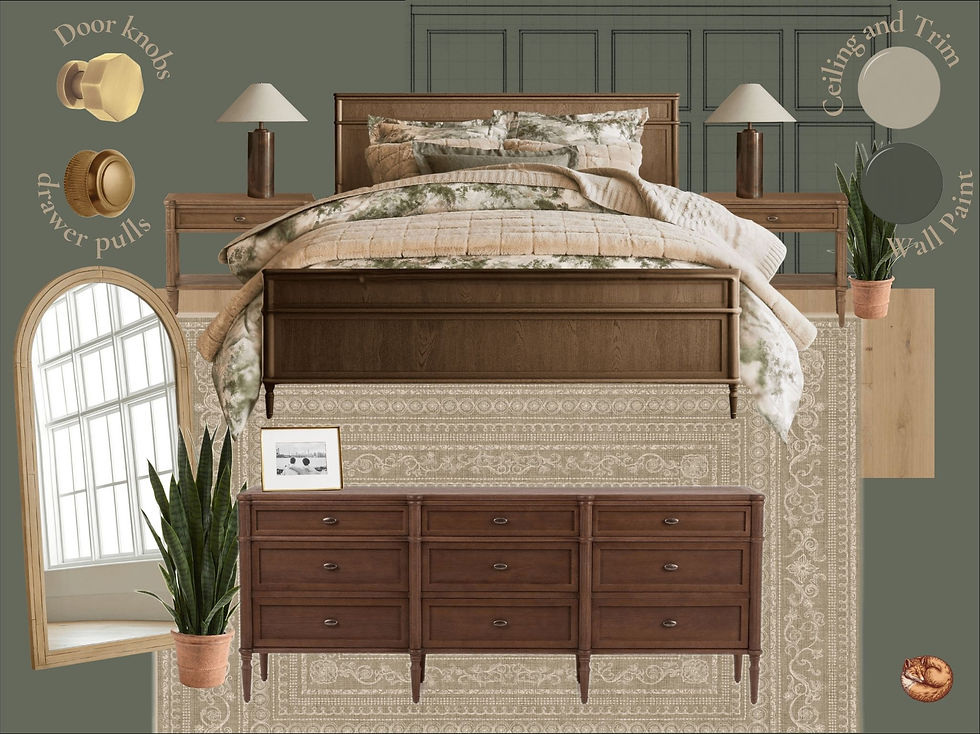Townhouse Kitchen: Layered, Lived-In, and Comfortable
- Tait Loughridge

- Sep 15
- 5 min read
Updated: Sep 18
This townhouse kitchen shows how even a relatively new build can be reimagined to feel more personal and welcoming. Builder-grade kitchens often default to practical but generic choices—gray-on-gray finishes, awkward appliance placement, and underwhelming details. With only one window serving the entire first floor, this kitchen also struggled with a lack of natural light.
By rethinking the color palette, relocating a few underperforming elements, and layering in architectural details, this townhouse kitchen becomes part of a larger story: a main floor designed to feel calming, cohesive, and comfortable.
Townhouse Kitchen Before
At first glance, the original kitchen looked perfectly fine—functional, clean, and typical of a newer build. But living with it day-to-day revealed its shortcomings. Gray cabinetry paired with granite counters and a diamond-pattern backsplash created a flat, cold atmosphere that never felt inviting.

The appliances highlighted the builder-grade compromises. Instead of a slide-in range designed to fit flush with cabinetry, the kitchen came with a freestanding stove. Its raised control panel rose awkwardly above the counters, breaking the visual lines of the space. The model also had finished side panels—an unnecessary detail hidden once installed—making it both less functional and less visually appealing than a proper slide-in.
Above it sat a microwave that doubled as the vent hood. Beyond its lack of suction power, it simply didn’t look right. A microwave over the range always reads as a compromise, one better suited to an apartment or very compact kitchen. In a townhouse kitchen with ample counter space and a large pantry, there were multiple better options. Placing it above the stove felt less like a design decision and more like a shortcut, one that left the space looking unfinished and under-considered.
With only one window to light the entire first floor, the kitchen already leaned dark. Combined with these builder-grade decisions and an open-concept plan with no architectural definition, the space felt generic and underwhelming.
Design Challenges
The first-floor layout is essentially one continuous space—living room, dining room, and kitchen all flowing together. That meant the finishes couldn’t be thought of in isolation; they had to tell a consistent story across the entire level.

The gray-on-gray palette, while standard for new builds, didn’t reflect the warm, grounded aesthetic envisioned for the home. To unify the floor, a new scheme was established: Rosemary green on every exposed sheetrock surface, paired with Peace of Mind, a warm cream, on all trim, doors, cabinetry, and paneling. The balance shifts naturally between rooms. In the kitchen, where walls are more prominent, the green comes forward. In the living and dining areas, paneling takes up larger sections of wall, so the cream is more dominant. The result is a palette that feels cohesive across the floor, while still giving each space its own proportion and presence.
Lighting was another priority. Rather than relying on reflective surfaces, the design focused on practical layers: under-cabinet fixtures for prep, a stronger light over the stove, a spotlight above the sink, and recessed ceiling lights for even illumination. Plans to eventually replace the solid front door with a glass-paneled one will also help bring in more natural daylight to the main floor.
Functionally, the range wall needed rethinking. Removing the over-the-range microwave freed space for a proper hood vent—an upgrade that required only a small cabinet adjustment but made a dramatic difference in both performance and appearance.
And finally, character was missing. The open plan blurred the kitchen and dining areas together in a way that felt unfinished. Without definition, the kitchen read more like a backdrop than the heart of the home.
New Townhouse Kitchen Design Concept
The new palette sets the tone for the transformation. In the kitchen, Rosemary on the walls grounds the space, giving it depth and contrast against the cabinetry. The drop-down beam, also painted green, frames the threshold to the dining area and adds architectural presence. The cabinetry and trim, finished in Peace of Mind, introduce warmth and connect visually with the living and dining spaces.

In those adjoining areas, Peace of Mind becomes more prominent through paneled walls and trim, while Rosemary still carries through on exposed sheetrock. This balance keeps the spaces connected without feeling repetitive.
Other finishes layer in texture and refinement. A terrazzo backsplash brings movement with warm brown and cream aggregates, paired with lighter stone-look countertops for a fresh but grounded foundation. A future counter-depth refrigerator with panel-ready fronts will integrate seamlessly into the cabinetry, avoiding the bulky look of standard models.

Architectural detail rounds out the design. A faux beam across the dining threshold creates the effect of a wall once removed but with the top foot still intact, softened with rounded corners. Inside the kitchen, three smaller beams on the ceiling bring rhythm and draw the eye upward, giving the space definition without lowering it.

Why This Townhouse Kitchen Works
What makes this redesign successful is that it embraces the open floor plan rather than fighting it. By carrying the same palette across all three spaces and allowing the proportions to shift naturally, the design avoids the “one big box” feeling that plagues many townhouses. Cream cabinetry and paneling tie the rooms together, while green walls and beams give the kitchen depth and weight.
The stronger vent hood, layered lighting, and simple relocation of the microwave make the kitchen far more practical for everyday cooking—without the expense or disruption of moving major appliances. And the added beams provide subtle architectural separation, so the kitchen feels defined without being cut off.
Above all, this townhouse kitchen works because it prioritizes comfort. It isn’t about chasing trends or gloss. It’s about creating a home environment that feels layered, lived-in, and truly welcoming.
Closing
This townhouse kitchen shows how thoughtful updates can completely shift the feeling of a space without a full remodel. With a palette that ties the entire first floor together, practical lighting, and architectural details that add character, the design transforms a standard builder-grade kitchen into one that feels personal, cohesive, and comfortable. It’s a kitchen designed not just to look good in photos, but to be lived in every single day.

Shop the Look
Love the feel of this townhouse kitchen? Here are a few of the elements that bring the space together:























Comments